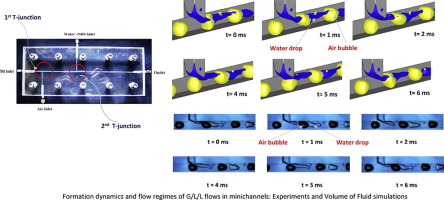Chemical Engineering Journal ( IF 13.3 ) Pub Date : 2018-01-11 , DOI: 10.1016/j.cej.2018.01.050 V.M. Rajesh , Vivek V. Buwa

|
Three-phase segmented gas-liquid-liquid (G/L/L) flows in minichannels are important to several chemical process applications involving gas-liquid-liquid reactions. In the present work, we have investigated segmented G/L/L flows in a double T-junction minichannel, with cross-section of 0.95 mm × 1 mm, through high-speed imaging experiments and Volume-of-Fluid (VOF) simulations. The dynamics of bubble/slug formation at the 1st T-junction and importantly that of water drop/slug formation at the 2nd T-junction was simulated under different flow conditions (; ; ) and different surfactant concentrations (0.3 and 2 wt/wt.%) in aqueous phase. The predicted formation mechanisms, three-phase flow regimes, and drop/bubble/slug lengths were compared quantitatively with the measurements. Different mechanisms of bubble/slug formation observed for the aforementioned range of the and , and bubble/slug lengths were predicted in a satisfactory agreement with the measurements. The complex formation mechanism of water drops/slugs that was governed by viscous force exerted by continuous oil phase, inertial force exerted by water phase, interfacial tension force acting on the oil-water interface and also by incoming air bubbles/slugs; could be predicted in a satisfactory agreement with those observed in the experiments. Different three-phase flow regimes, e.g., drop-bubble, drop-slug and slug-slug, observed for different oil, air and water flow rates; and for different values of oil-water interfacial tensions are also predicted in satisfactory agreement with the measurements. The results reported in the present work help to understand the hydrodynamics of complex three-phase gas-liquid-liquid flows in minichannels, which in turn is crucial to device microreactor systems for process applications involving G/L/L flows.
中文翻译:

微型通道中气液液流动的流体体积模拟
微型通道中的三相分段气-液-液(G / L / L)流量对于涉及气-液-液反应的多种化学过程应用很重要。在当前工作中,我们通过高速成像实验和流体体积(VOF)模拟,研究了截面为0.95 mm×1 mm的双T型小通道中的分段G / L / L流量。在不同的流动条件下模拟了第一T形结处的气泡/团块形成动力学,重要的是模拟了第二T形结处的水滴/团块形成动力学(; ; )和水相中不同的表面活性剂浓度(0.3和2 wt / wt。%)。将预测的形成机理,三相流态和液滴/气泡/团块长度与测量值进行了定量比较。在上述温度范围内观察到不同的气泡/团块形成机理。 和 和气泡/团块长度的预测与测量结果令人满意。水滴/团块的复杂形成机理受连续油相施加的粘性力,水相施加的惯性力,作用于油水界面的界面张力以及进入的气泡/团块控制;可以与实验中观察到的结果以令人满意的协议进行预测。对于不同的油,空气和水流速,观察到了不同的三相流态,例如滴泡,滴塞和塞塞。对于油水界面张力的不同值,也可以与测量结果令人满意地进行预测。本工作中报告的结果有助于了解微型通道中复杂的三相气液液流动的流体动力学,











































 京公网安备 11010802027423号
京公网安备 11010802027423号